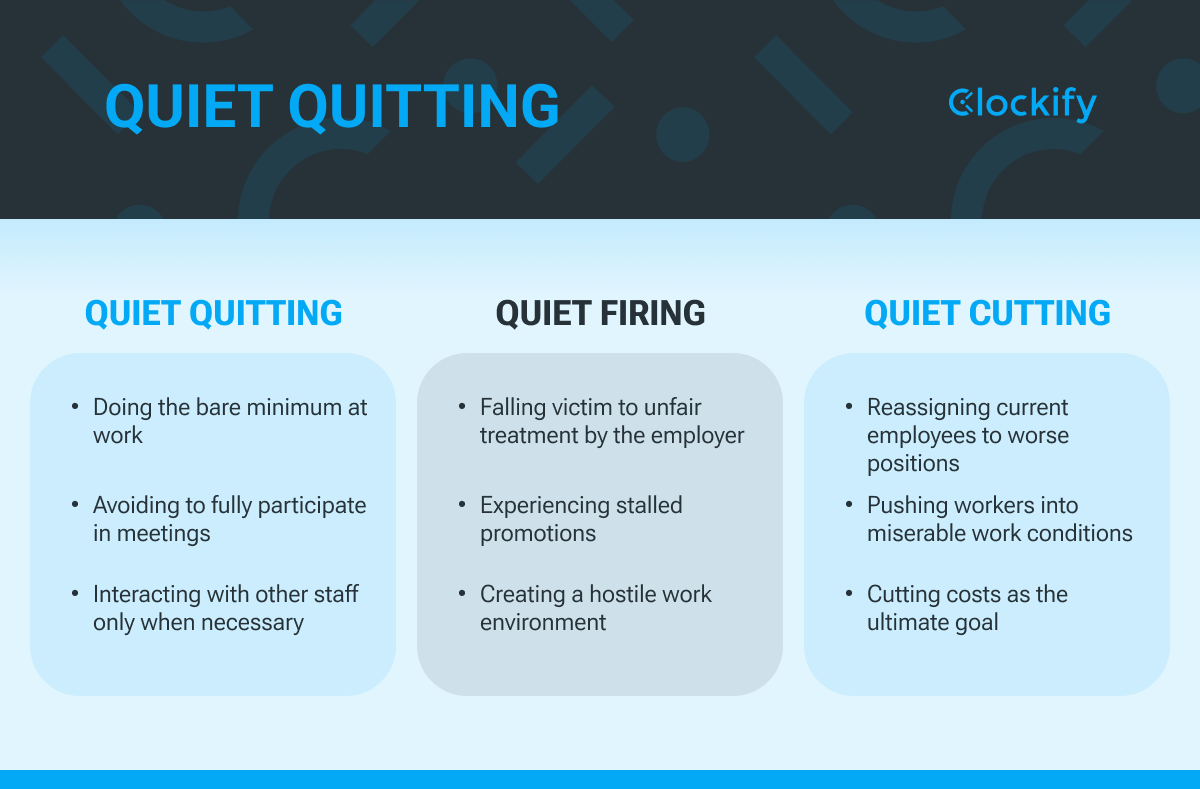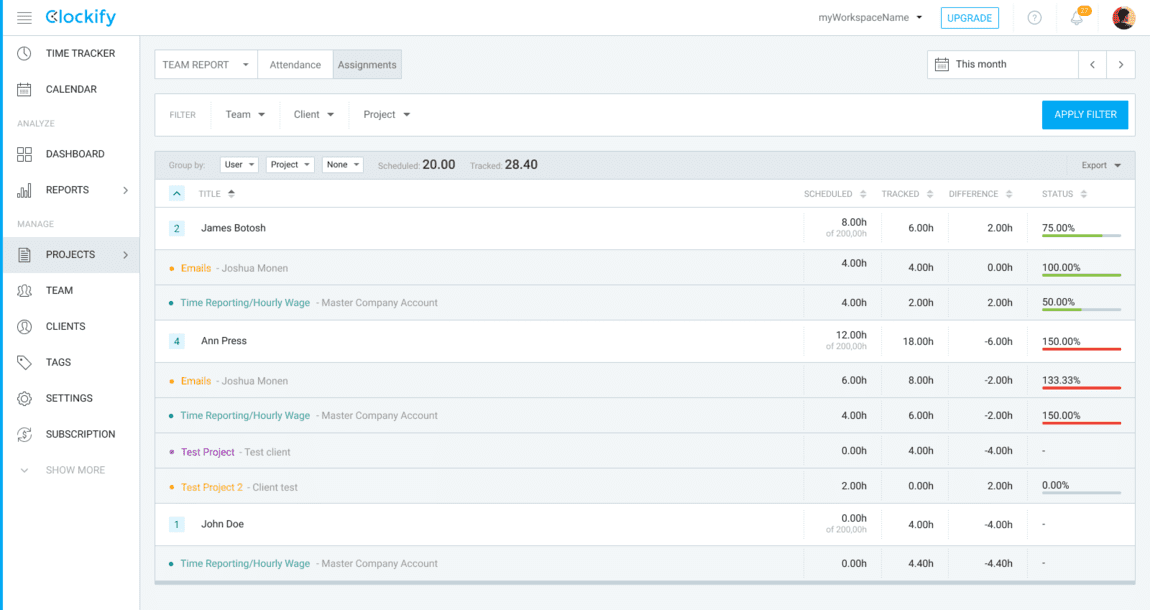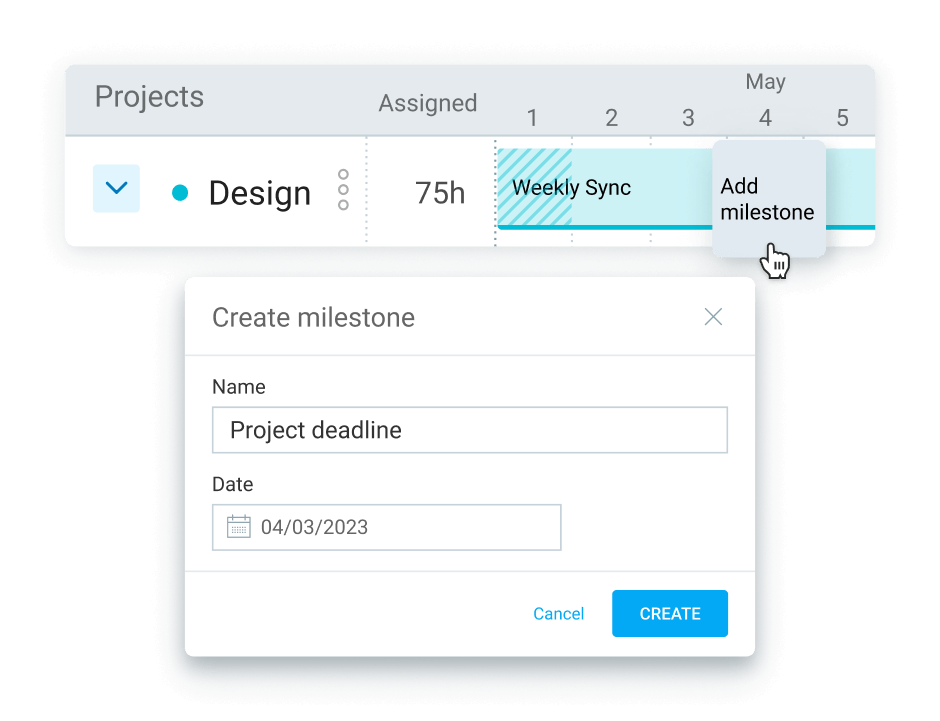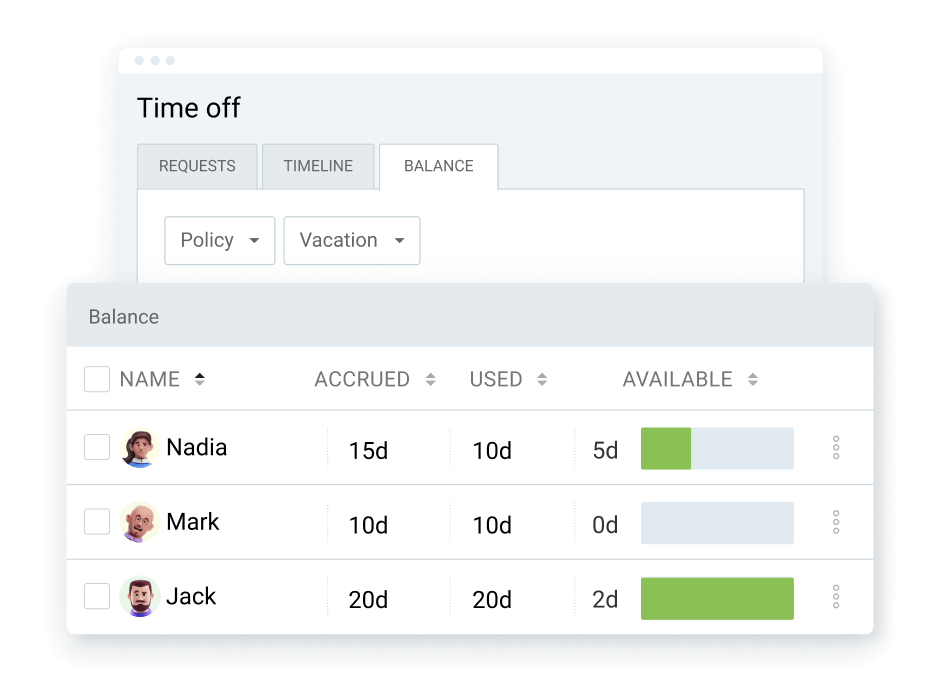What Is Quiet Quitting: Definition, Origin, and Tips
Last updated on: October 18, 2023
The quiet quitting trend is taking the world by storm — workers are fighting back!
Over are the days of silent employees who bear the brunt of poor management and suffer from a staggering lack of career opportunities. Workers aren’t taking it any longer.
We know it sounds far-fetched, but bear with us.
In this article, we’ll explore:
- What quiet quitting is in 2023 and beyond,
- How to recognize the signs of quiet quitting,
- If quiet quitting is healthy, and more.
Buckle up as we dive deep into the exciting inner lives of quiet quitters.

Table of Contents
What is quiet quitting?
According to the Wall Street Journal definition, quiet quitting — also known as soft quitting and silent quitting — is the same as “not taking your job too seriously.”
In any case, quiet quitting is a new term that explains how and why employees do the bare minimum at work. In its simplest form, workers who quietly quit do not invest any more effort and time in their work than necessary.
Yet, quiet quitters beg to differ.
For example, they may argue that they are simply making a healthy work-life balance. In fact, many quiet quitters think that setting firm boundaries and spending time on personally fulfilling activities doesn’t equate with disliking their job. In other words, quiet quitters often reject the notion that life should be all about work.
And that’s where the confusion arises — no watertight definition has so far been made for quiet quitting. As a result, this leaves plenty of room for different interpretations.
Whatever the definition we prefer, this phenomenon is probably here to stay in one form or another. But where did it come from? Let’s explore the roots of quiet quitting.
Is quiet quitting real? What are its origins?
Although a viral topic, quiet quitting isn’t yet another news trend. In fact, experts think of it as one of the great workforce shake-ups of our time.
Arguably, the first popular mention of quiet quitting comes from career coach Bryan Creely, who used to be a corporate recruiter. Creely posted a video on TikTok claiming that quiet quitting is about “doing the minimum amount necessary in order to still maintain your position.”
But that’s just one side of the coin.
HR professionals debate the origins of quiet quitting. Some say it comes from the Great Resignation — when dozens of millions of employees quit their jobs voluntarily and abruptly in 2021. Still, other experts claim that the Great Resignation started back in 2009, only to reach its peak during the recent pandemic.
Finally, some credit the economist Mark Boldger with coining the term back in 2009.
Interestingly, however, one conference paper states that quiet quitting had a predecessor in China.
In 2021, the country’s hardworking and production-oriented culture was hit hard by Tang Ping (translated as Lying flat). This term suggests a breakup from the Chinese version of hustle culture — a workplace atmosphere where the focus is on intense ambition, success, and productivity at the expense of rest and work-life balance.
Be that as it may, who is to blame — or credit — for the widespread nature of soft quitting?
Whose fault is it that employees are quietly quitting?
We want to discuss an issue as old as time: Do problems arise due to bad management or bad employees?
The truth is that leaders have a lot more responsibility than their employees when it comes to quietly quitting.
An article by Harvard Business Review brings home this point. The authors state that their data indicate that “quiet quitting is usually less about an employee’s willingness to work harder and more creatively, and more about a manager’s ability to build a relationship with their employees where they are not counting the minutes until quitting time.”
In other words, if the manager isn’t engaged at work, this will negatively affect employees. As another in-depth investigation by HBR suggests, “approximately two-thirds of managers are either not engaged or actively disengaged in their work and workplace.”
On the flip side, data from the Pew Research Center suggest that 62% of employees say they are very satisfied with their supervisor or managers. Yet, only 34% of employees are happy with their salaries, and a mere 33% state they are satisfied with their opportunities for developing new skills.
In any case, quiet quitting often happens because employees feel they are wasting their time and effort in a toxic work environment. This term describes workplaces where constant conflict persists between employees, managers, and across both of those groups.
Speaking of toxic environments, time management and productivity coach Alexis Haselberger says that she doesn’t view soft quitting as a bad thing per se:

“I don’t think quiet quitting is a totally negative thing, but rather a reasonable backlash to toxic productivity and capitalist culture.”
If that wasn’t mindblowing, wait until we meet quiet quitting’s look-alikes. That’s next.
Quiet quitting vs. quiet firing vs. quiet cutting
Quiet quitting is as real as its dark counterparts: quiet firing and quiet cutting.
In simple terms, quiet quitting is all about:
- Interacting with fellow coworkers only when necessary,
- Avoiding to fully take part in meetings, and
- Doing the bare minimum at work.
But unlike quiet quitting, quiet firing and quiet cutting are coming after the employee. In other words, it’s the manager, supervisor, or employer who is actively working to create unbearable work conditions.
Let’s expand more on quiet firing and quiet cutting.
For simplicity’s sake, quiet firing is about giving the employee minimum benefits and wage to force them to quit voluntarily. So, the manager or employer makes the job so unrewarding that the employee has no other choice but to leave. Less obviously, an employee in this situation will likely get passed over for a well-deserved promotion.
With quiet firing, employers intentionally create a hostile work environment to drive employees out.
In fact, some companies have recently made headlines for their practice of quiet firing. Sadly, many employees don’t see it coming. As a result, they find themselves in a difficult situation when it happens.
On the other hand, quiet cutting means that a company reassigns its current employees to roles that don’t exactly fit their skill set. The goal? To push workers into performing work tasks that the company needs to do to reduce hiring costs — without any care for the employee’s needs.
For example, a manager may inform an employee that the company has eliminated their job role. Yet, they go on to say that the employee is staying in the company and given a day or two to choose between a few equally unfavorable job titles for the same pay.
With quiet cutting, companies aren’t really laying off personnel, but they are cutting their costs for sure. As a result, workers are pushed into miserable working conditions.

—
Now that we’ve touched on the gloomy siblings of quiet quitting let’s refocus on our main topic. In fact, how widespread is quiet quitting really?
How common is quiet quitting?
Quiet quitting is spreading like wildfire.
To back up that claim, employee engagement statistics for the US and Canada suggest that only 33% of the workforce is actively engaged in the workplace. As you can imagine, the remaining 67% could potentially be quiet quitters in the making.
Likewise, the employment platform Monster has revealed similarly disturbing data. They claim that 60% of employees stated they’re quietly quitting or at least thinking about it. The reason? Underpaid labor!
In a similar fashion, late 2022 data from the Society for Human Resource Management (SHRM) unequivocally proved that quiet quitting is rising rapidly. In fact, the authors of the study claim that as many as 51% of HR professionals are worried about employees softly quitting their jobs.
After so much convincing data, the short and sweet answer is a resounding yes — it looks like quiet quitting is just taking off.
So, what can managers do to recognize signs of quiet quitting? We’re so glad you asked, because we’re now going to focus on just that!
What are the signs of quiet quitting?
Writing for Forbes, Bryan Robinson, Ph.D., stresses that quiet quitting costs companies $150,000,000 every year. Well, that looks like money they shouldn’t be throwing away.
So, it pays to notice the signs of quiet quitting as early as possible — and address them.
If you pay attention, you can easily spot a few prevalent red flags in quiet quitters’ behavior.
To explain the signs of quiet quitting, we spoke to HR reps, productivity experts, and career coaches.
In a nutshell, the most telling signs of quiet quitting include:
- Isolation,
- Taking longer to do anything work-related,
- Employee disengagement, and
- Taking an unusual number of sick days.
Let’s explore each of these red flags in more detail — supercharged with expert advice.
Sign #1: Isolation
When employees isolate themselves from other team members, that’s a surefire path to disaster team-wise.
To avoid teams falling apart, the manager has to assess if each individual worker’s attendance at mandatory meetings looks like a potential sign of soft quitting — or if the employee is genuinely interested in contributing.
One way to notice signs of team disintegration is when an employee rarely has anything to add or they are visibly impatient to see the meeting end.
Founder of The New Workforce — a collaborative platform for teams in various industries — Kraig Kleeman speaks to the importance of recognizing when employees are disinterestedly moving away from coworker gatherings:

“Employees who gradually distance themselves from team activities and social interactions within the workplace may quietly quit. They may eat lunch alone or avoid team events.”
In other words, merely tolerating gatherings isn’t proof of soft quitting. For example, shy people often avoid socializing with coworkers, but that isn’t evidence they are quietly quitting.
Yet, if some workers repeatedly skip joint activities, this can be a sign of quiet quitting.
Sign #2: Taking longer to do anything work-related
Deadlines are among the first victims of quietly quitting. In fact, quiet quitters sometimes neglect their job duties to the extent that they always need a few extra days to complete their tasks.
Deadlines are just one piece of the puzzle. Here are some other silent quitting indicators, according to Chris Wong, executive coach and consultant:

“Common signs of quiet quitting are taking longer to complete tasks, taking longer to reply to emails/voicemails, increased absences.”
When employees consistently need more time to get a task done, managers should start an open conversation on why that is. If the manager keeps on noticing the same issues with failing to meet due dates, then a thorough analysis is necessary to establish the level of employee motivation.
Also, employees may consistently forget to get routine tasks done — tasks they had previously completed diligently.
Sign #3: Employee disengagement
When employees quietly quit, they often only focus on their work. In other words, quiet quitters tend to avoid taking part in coworkers’ projects. Likewise, volunteering isn’t an option.
In a nutshell, a distinctive sign of quiet quitting is — chronic disengagement.
General recruiter at Jooble, Victoria Potapenko, thinks that employee disengagement takes many forms:

“An employee experiencing quiet quitting no longer strives to excel, assist colleagues, or prove themselves as a valuable team member. Additionally, they do not converse with their manager about their future career ambitions.”
Even more specifically, not speaking up during team meetings could be a sign of quiet quitting.
Founder of The New Workforce we referenced earlier, Kraig Kleeman, thinks that managers can notice subtle cues in whether the employee has lost interest in their work:

“A decrease in asking questions or seeking clarification on tasks can indicate that an employee has lost interest in their work. They may go through the motions without trying to understand the bigger picture.”
💡 Clockify Pro Tip
The opposite of diminishing participation is — you guessed it — excessive participation. Get your workaholic hat on and learn about workaholism facts and stats:
Sign #4: Taking an unusual number of sick days
When an employee softly quits, they sometimes take an unreasonable amount of sick days. In turn, this results in employee absenteeism — the habitual absence from work.
Simply put, an employee may be dishonest about how many sick days they actually need to recover — over and over again.
Working at CAKE.com, Human Resources Generalist Ena Popović believes that a manager can tell if an employee is misusing their sick days:

“One way is that the worker is taking sick leave far more often than the rest of their colleagues. In fact, they may be avoiding to speak about their current health. Also, a continued poor quality in work produced — such as decreased productivity and proactivity — before taking sick leave can be a telling sign.”
But things don’t end here. Ena Popović thinks that managing emotions is equally vital:

“Emotional distancing from work and a lack of motivation to acquire new knowledge and skills can also constitute red flags.”
Quiet quitting examples
Examples are the best way to learn about anything. Go figure, right?!
In this segment, we’ll explore a few real-life scenarios of quiet quitting.
Let’s start with how employees may distance themselves from volunteering opportunities.
Example #1: Employee neglects to volunteer for new tasks
Part of every modern-age job is to occasionally help out a coworker by volunteering to do a tiny task here and there. It’s what everyone expects.
Yet, quiet quitting takes that sense of companionship away.
Productivity coach Alexis Haselberger emphasizes that not volunteering for extra activities at the office may be a good example of quiet quitting:

“An example of this may be an employee who works hard during work hours and gets all their deliverables completed on time, but who isn’t volunteering for extra labor.”
Still, teamwork is often at odds with this way of operating at work. In fact, team members may occasionally need their coworkers to lend them a hand on extra tasks. And this inability to contribute to the team by doing an additional assignment here and there constitutes one of the biggest drawbacks of quiet quitting.
💡 Clockify Pro Tip
Nobody gets served a team — a team is created in time. Find out dozens of pieces of advice on how to establish a culture of teamwork:
Example #2: Employee doesn’t show dedication to work
Recruitment expert Travis Lindemoen, who also runs the accompanying nexus IT group, talks about the downward spiral of quiet quitting:

“A few years back, I was working on a project with a colleague, let’s call him Mike. At first, Mike was enthusiastic and full of ideas, but over time, he started becoming quieter in meetings, missing deadlines, and seemed disengaged. One day, I asked him how things were going, and he confessed that he was feeling overwhelmed and undervalued, but he didn’t want to make a fuss.”
Travis Lindemoen stresses this as a classic example of quiet quitting. And he isn’t alone.
Executive coach Chris Wong believes that the failure to bring up new ideas can be a solid illustration of quietly quitting:

“A simple example of quiet quitting is an employee who previously brought up new ideas or willingness to improve processes but suddenly does not bring any new ideas and/or takes longer to complete tasks as they don’t have the same sense of urgency or desire to complete work.”
💡 Clockify Pro Tip
To tackle any task, you need a foolproof time management system. Learn about some of the most effective techniques in our in-depth guide:
Example #3: Employee fails to show enthusiasm
Enthusiasm isn’t required to do your job well. Yet, it can be a useful trait as it motivates employees to perform better.
To that effect, expert Kraig Kleeman believes that the shift from proactive to passive employee happens in a flash:

“A simple, rather blatant example of quiet quitting could be an employee who used to be proactive in seeking out new projects and challenges but has recently become passive, only doing what is explicitly assigned to them. They no longer volunteer for extra tasks or contribute innovative ideas to improve processes, showing a lack of enthusiasm for their role.”
Whatever the signs and examples of quiet quitting, most managers want to understand how to prevent quiet quitting from ever happening.
We’re diving deep into this topic next.
How to prevent quiet quitting
As with any other workplace phenomenon, you can nip quiet quitting in the bud with a few decisive actions.
But how?
We picked the brains of a few experts to learn exactly that.
And yes — here you’ll find advice on what employers and employees can do to help.
Tip #1: Eliminate unnecessary tasks
The first one sounds like common sense — because it is. Likewise, this piece of advice is mostly meant for employers. But, how employers implement this suggestion directly impacts the performance and workload of their employees.
Leadership coach Ayanna E. Jackson believes that you can always trim some unnecessary tasks:

“Take a moment to assess: What should we stop? What doesn’t need to continue? What do we need to do less of? Many times leadership is in perpetual ‘add mode’ to the complete detriment of their employees. We don’t stop to think: What wasn’t successful that we need to stop? Where are we short-staffed and the staff that remains is doing work that doesn’t need to be done?”
Ayanna E. Jackson continues by saying that we should be wise about choosing our priorities:

“Everything isn’t important or a priority, but we’re so focused on productivity, especially in light of remote work, that we end up with employees doing the bare minimum – quiet quitting – by nature of our own work practices.”
Likewise, executive coach Chris Wong thinks that managerial staff should carve out time to revisit cumbersome procedures:

“A simple example of quiet quitting is an employee who previously brought up new ideas or willingness to improve processes but suddenly does not bring any new ideas and/or takes longer to complete tasks as they don’t have the same sense of urgency or desire to complete work.”
If done correctly, this employer behavior can benefit the employee, freeing up more mental energy and time to complete other mission-critical tasks. In other words, the number of quiet quitters in the organization is likely to drop when employers understand that revisiting employee workloads helps everyone become more productive.
💡 Clockify Pro Tip
Learn about the benefits of time management for managers and employees in this handy manual:
Tip #2: Pay workers what they deserve
According to a 2023 analysis by ADP Research Institute, 42% of female and 46% of male respondents claim they are underpaid. That’s a striking statistic, suggesting that employers need to up their pay game to increase worker satisfaction.
Managing director of Marketing Signals, Gareth Hoyle, says that employers need to show their staff that they are appreciated and valued:

“I know we’re in the middle of a cost-of-living crisis. But if your workers are on low pay and working really hard, they may want to leave to find better pay elsewhere. If you’ve noticed a decline in work from your workers, you could implement a bonus scheme so that workers receive points each time they do something well, which can equate to money.”
When managers notice top-performing workers, they should consider giving them a raise. In turn, the employee will feel more satisfied and the overall productivity of the team will likely increase. And yet, it’s not all about money — and that’s up next.
💡 Clockify Pro Tip
Learn how to calculate increases in pay with this helpful resource that explains different kinds of raises based on time spent in the company, market demand, and more:
Tip #3: Recognize and praise employees
To build trust and boost morale, managers should regularly praise and reward employees who’ve done their job well.
In line with that, general recruiter at Jooble, Victoria Potapenko, believes that recognition doesn’t always equate to more money:

“It’s not always about monetary incentives. Sometimes, employees need recognition, acknowledgment of their contributions, and positive feedback from their managers. During meetings with employees, go beyond discussing work-related matters and take the time to thank them for their efforts and praise their achievements.”
Speaking of praise, recruitment expert Travis Lindemoen brings home the point on the power of a simple sign of gratitude:

“Recognize and appreciate your team’s efforts. Sometimes, quiet quitting happens when people feel undervalued. A simple ‘thank you’ or acknowledging their hard work can go a long way in boosting morale and preventing quiet quitting.”
But, it’s hard to establish who has put in extra effort.
On that front, apps like Clockify show you how each team member contributes to the team by looking at who is more efficient at completing tasks. As a result, this may be a signal for management to provide positive feedback and praise the employee in question.
For example, the assignments report in Clockify helps you compare scheduled versus tracked time to understand timekeeping trends better.

What’s more, the assignments report lets users:
- See the progress for multiple projects of one client, and
- Compare between the progress pace of different teams and individual employees.
By carefully learning which employees perform better than others, managers can easily decide who to openly praise. Apart from that, management can also make corresponding decisions on raises and bonuses for top-performing workers.
Tip #4: Conduct regular check-ins
Healthy communication between supervisors and employees always goes a long way.
For example, a survey by SHRM suggests that regular check-ins help calm anxiety among employees.
Kraig Kleeman from The New Workforce is convinced that frequent meetings with supervisors — or HR staff — can yield immense benefits:

“Schedule one-on-one meetings with employees to discuss their workload, challenges, and career aspirations. This provides a platform for them to voice any concerns or frustrations and allows you to address issues proactively.”
In fact, these meetings should take place once per week and last for about 15-30 minutes. These regular check-ins can serve as an outlet for the manager and employee to discuss:
- Recent accomplishments and issues,
- Career development,
- Ideas and plans, and even
- Personal situations of the employee (if the employee thinks it’s appropriate).
💡 Clockify Pro Tip
Find out how to manage your workforce like a pro with our in-depth guide on workforce management:
Tip #5: Be open and honest to your coworkers
This one applies to employees and employers alike.
According to a report by Michigan State University, “transparent communication is the act of both good and bad information being shared upward, downward, and laterally in a way that allows all to see the why behind the words.”
However, managing director Gareth Hoyle thinks that not every single person will be candid in their day-to-day communications:

“Not everyone will be open and honest with you through fear of repercussions. Try creating a culture where workers feel happy to come to you or another manager with any issues so that they can be resolved quickly without turning into resentment.”
To wrap up, general recruiter Victoria Potapenko thinks that open and honest communication is the cornerstone for resolving problems:

“Engage in clear and frequent communication with your employees. Discuss their concerns openly and express your willingness to support and assist in task distribution. Silent dismissal often evolves from burnout issues.”
In other words, quiet quitting also arises when employers don’t offer support to their employees and engage in clear communication with them. You can easily avoid such situations — by keeping communication transparent.
Tip #6: Grant time for career development
A 2023 survey by the American Psychological Association suggests that the vast majority of US employees (91%) think it’s quite important to work at a job with consistent growth opportunities.
No surprise there!
But what is surprising is the survey’s finding that a mere 47% of employers offer those opportunities.
Leadership coach Ayanna E. Jackson presses on the point that employers need to provide the space for employees to develop themselves:

“Employees are constantly asking for career development, promotions, skill building. We love stretch assignments. What don’t we love? Giving time to do it. Leadership has to actually give employees the time and space to learn and grow. This means taking 1-2 hours a week to attend the training – uninterrupted.”
If you want to better track how your coworkers are progressing on their career development path, we advise using a time tracking system.
For example, Clockify’s scheduling feature allows you to create milestones. You can use this functionality to track how your employees are advancing in their professional development.

Apart from that, you can choose the amount of time you think workers need to complete a professional development goal. That way, employers and employees can learn how much time they need approximately to learn a certain skill or adopt new knowledge relevant to their job.
Tip #7: Send employee engagement surveys
Occasionally, managers have to get some hard-hitting advice from their direct reports.
Every month or so, supervisors and other managerial staff can send out surveys to test if widespread disengagement is ravaging their workforce. Such surveys typically include questions on:
- Job satisfaction,
- Employee commitment and motivation,
- Company fit,
- Sense of purpose in the workplace, and others.
To ask these questions regularly means to make educated guesses about what employees are up to.
But don’t take our word for it.
HR consultant at face2faceHR, Rachel Weaven, thinks that employee engagement surveys can be a handy tool to check the pulse of the workforce:

“When companies are busy making products and keeping customers happy, then a ‘quiet’ employee can often be overlooked, which is where engagement surveys come into play. Whilst some people don’t fill them in, there is a chance as a business you can monitor the morale and culture of the company through these.”
Similarly, the director of Kincentric — a company that focuses on employee experience and culture — Kamela Lupino, believes that it’s not just employees who benefit from employee engagement surveys:

“Organizations reap full benefits when they listen to employees (and act on what they hear). It’s ultimately up to executives to drive a consistent employee experience that creates an engaged workforce.”
Tip #8: Understand sick leave patterns
According to the US Bureau of Labor, almost 8,000,000 employees took sick leave in January 2022 alone. Yet, not all sick days are spent on recovering from an illness — some employees abuse their sick leave and spend that time on other things.
If one employee takes sick days more often than others, this can signal to the manager that the employee is lacking in motivation — or quietly quitting.
So, what can you do about it?
For starters, you can use a time tracking software to create a sick leave policy. With Clockify’s PTO and vacation tracker, you’ll be able to set an exact number of days employees can use for sick leave (and other types of leave, too).
Then, simply keep track of the number of sick days an employee takes — and then liken it to others in the company.

Likewise, a sound time tracking system lets you compare accrued days versus used days. That way, managers can tell if somebody is misusing their time off.
💡 Clockify Pro Tip
Speaking of absenteeism, how can managers make sure their employees are performing well? Read our guide on more than 15 solid ways to enhance productivity at work:
Frequently asked questions about quiet quitting
Next, we’ll explore a few frequently asked questions about quiet quitting, including the ones on:
- Triggers of quiet quitting,
- Intentions behind quiet quitting,
- Health concerns with regard to quiet quitting, and more.
Let’s get into each of these.
What triggers quiet quitting?
The single biggest trigger for soft quitting is job dissatisfaction.
But that’s just one big umbrella term that means many things.
Namely, a concrete trigger is a lack of employee recognition. In fact, such managerial behavior sets the stage for quiet quitting. When employees feel overworked and undervalued, they are more likely to softly quit their jobs.
Similarly, when people lack flexibility in the workplace, they tend to slowly incline towards the so-called quiet quitting period (more on that later).
Another powerful trigger for quiet quitting is when employers disregard the need of their employees to focus on:
- Travel,
- Family,
- Passion projects, and
- Other areas outside of work.
On the other hand, when employees don’t feel trapped in their job role, they are more likely to contribute to their company’s bottom line.
Is quiet quitting intentional?
Quiet quitting is the employee’s natural and deliberate response to toxic work situations and low incentives.
Strategic HR advisor and CHRO at Plotline Leadership, Tim Toterhi, thinks that quiet quitting is definitely a willful decision to act in certain ways:

“Quiet quitting is the act of doing exactly what you were hired to do as promised — no more, no less. It’s a matter of opportunity cost. An employee can work more for free and hope for an eventual reward. Or they can devote that extra time to family, friends, hobbies, or a side hustle that actually pays.”
Is quiet quitting lazy?
When the recent pandemic triggered quiet quitting among those below 35 — Millennials and Generation Z — elderly workers thought of it as mere laziness. Yet, there’s more to it than meets the eye.
In fact, a 2023 research article on reimagining quiet quitting suggests that quiet quitting was “an enhanced way of dealing with job stress, disengagement, and burnout.”
So, it would be unfair to suggest that quiet quitting is about younger generations being lazy. In contrast, quiet quitting is a new workplace revolution that puts employees’ needs first. Of course, that’s not to say that there aren’t any lazy people slacking off at work — but they are not necessarily quiet quitters.
Is quiet quitting healthy?
Since quiet quitting entails doing the bare minimum at work, it’s a safe bet to assume that it also reduces stress and burnout. An antidote to hustle culture, quiet quitting can free up space in the day to spend time with family and friends — but also work on passion projects.
Still, whether quiet quitting is healthy really depends on the individual. For example, some employees may be quietly quitting due to a lack of meaning at work.
For instance, doing the bare minimum might suggest the employee has lost a sense of meaning at work. To that effect, an interesting 2023 HBR article pointed out that “meaningfulness is more important to us than any other aspect of our jobs — including pay and rewards. When we experience our work as meaningful, we’re more engaged, committed, and satisfied.”
However, a lack of meaning can negatively affect a person’s well-being. For example, a 2022 article in the MIT Sloan Management Review points out that a lack of meaning can create “feelings of discontent, emptiness, and sadness.”
So, yes, quiet quitting can be unhealthy if it promotes the loss of meaning at work.
What is the quiet quitting period?
Quiet quitters don’t become quiet quitters overnight. It happens over weeks or months of piling up dissatisfaction with various areas of work.
But when quiet quitting starts, the end often isn’t in sight.
HR advisor Tim Toterhi, whom we mentioned earlier, is confident that quiet quitting doesn’t have a specific expiration date:

“There is no set period. Employees quietly quit as soon as they realize that many companies have devised HR processes to take advantage of employees. They hire you for a role and immediately expect you to do more than they pay you for. Check your job description. No doubt, you’ll see a convenient phrase listed in the responsibilities section — the old ‘other duties as assigned.’”
Similarly, HR consultant Rachel Weaven thinks that the quiet quitting period depends on the company culture:

“I don’t think there is a timescale when it comes to quiet quitting — it depends on the culture of the business. Signs to look out for will be staff disengaging from conversations to do with the business, sticking to their core hours, and maybe unwilling to do tasks that sit outside of their job descriptions.”
Sum-up: Quiet quitting happens when employees feel unrecognized and non-incentivized
Quiet quitting is a loaded term. Yet, that doesn’t mean that quiet quitters are as quiet as they used to be. In fact, they are increasingly voicing their concerns.
And for good reason.
In this article on quiet quitting, we covered the signs and examples of quiet quitters, including:
- Isolation,
- Minimal questions,
- Less stress and burnout,
- General disengagement, and
- Taking longer to do anything work-related.
But let’s also recap a few words of advice from the experts we spoke to. Most of them seem to think that managers should:
- Pay workers fairly,
- Recognize their employees consistently,
- Conduct regular check-ins,
- Grant time for career development, and
- Remove unnecessary tasks and workloads.
Finally, always keep in mind that work productivity is a 2-way street. In other words, the employee and the employer have to invest efforts to make things work. Both sides will be better off for it — we promise!
✉️ Got any tips, suggestions, or questions on quiet quitting? Drop us an email at blogfeedback@clockify.me for a chance to have your questions answered or your suggestions and tips featured in future updates of the post. Also, if you liked this blog post, share it with someone who might benefit from reading it.




